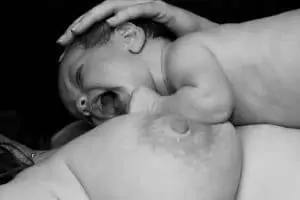Breastfeeding mothers often need to give their baby a bottle, whether it’s due to working or needing a few hours to be alone per week. You might also decide that your child would be happier with a pacifier; that’s a personal parenting decision. However, introducing a bottle or pacifier can cause nipple confusion, and if you want to continue breastfeeding, you’ll need to learn how to fix nipple confusion.
I know some people who wonder if nipple confusion is legitimate, and the answer is yes! While it doesn’t happen with all babies, it does happen for some. I had four kids, and only one faced nipple confusion issues, but it can be overcome and fixed.
Some people say that nipple confusion isn’t real because it doesn’t happen to all babies. That’s not true; nothing applies to all children. While most babies will be fine if you offer pacifiers and bottles, pacifiers cause nipple confusion for some infants.
Breastfeeding moms need to understand nipple confusion and make transitioning between breast and bottle easier for your baby.
What is Baby Nipple Confusion?

Nipple confusion is when a breastfed babies who have trouble latching onto the breast and feeding effectively after feeding with a bottle or taking a pacifier. Babies struggle to get an appropriate latch.
It can be confusing to understand why nipple confusion happens. Here’s the reason why some babies struggle.
When a baby latches onto a breast, he has to use a different technique than when he feeds from a bottle. Babies can effectively control the flow of milk from their mother’s breast by creating a suction, and they can easily pause while swallowing and breathing. All of this does involve work on the baby’s end.
Drinking from a bottle doesn’t take as much work as breastfeeding does. Gravity contributes to the ease, and the bottle nipples allow the milk to flow without much suction. It requires less jaw work for your baby to use a bottle.
So, when your baby uses a bottle then transitions back to the breast, he might forget that the milk flows differently. He also has to latch differently; latching onto your breast requires your baby to open wide, but he doesn’t need to do that for bottle feeding.
Some babies can switch back and forth with no problems, but some hit a stumbling block when coming back to the breast.
It’s important to note that you cannot predict if a baby will struggle with nipple confusion. It’s an individual problem; not all breastfed babies will face this.
What Does Nipple Confusion Look Like?
Moms can look for nipple confusion signs to let you know that your baby is struggling with transitioning. While one bottle typically doesn’t cause nipple confusion, you should know what are concerning signs.
Here are the nipple confusion symptoms.
- Your baby might thrust his tongue up while sucking, which pushes the nipple out.
- He won’t open his mouth wide enough when trying to latch onto your breast. Nipple latching is common, so your nipples might end up being sore or cracked.
- Your baby might latch onto your breast, suckle for a few moments, and get frustrated when the milk isn’t available immediately. Milk takes longer to appear because the letdown reflex must be triggered, and when they’re used to the instant milk from a bottle, this can be frustrating.
How to Fix Nipple Confusion?
Since you can’t predict this, it’s recommended that you establish breastfeeding well before giving a bottle or pacifier. The recommendation is that parents wait until their baby is 4-6 weeks old before introducing one, but that can feel like a long wait for a mom who needs a break or when you need to go back to work.
Going back to work is perhaps the biggest concern. If you wait too long to introduce a bottle, breastfed babies are known for refusing to take a bottle. What works for one baby might not work for another, so it’s often a trial by gunfire.
Correcting nipple confusion is possible; you don’t need to stick to a bottle or give up breastfeeding entirely. It’s most common to have a newborn with nipple confusion, and they adjust after time. Here are some suggestions.
Deal with Engorgement Before Nursing
Latching onto an engorged breast is hard for a baby who isn’t confused; it can be like trying to latch onto a football with a nipple. It’s a good idea to hand express some breast milk to soften your breast and areola before latching your baby. If you don’t want to hand express, use a breast pump on the lowest suction setting.
Pressure Soften Your Breasts
Here is a unique technique that works well with most babies. Take your fingertips and put them on the base of your nipple, and apply gentle yet steady pressure for a minute. Doing this creates a ring of simple indentations, causing the fluid to move away from this area. It softens your nipples, making it easier to latch.
You also can do this with the sides of your fingertips. Your thumb would go on one side of your numb while two of your fingers press against the other side.
Use the Deep Latch Techniques
When you have nipple confusion from a pacifier or a bottle, encouraging a deep latch with a wide-open mouth can help. You can cup your nipple, making a C-shape with your hand around your breast, and present it to your baby. Point your nipple towards your baby’s nose, which will cause your baby to open wider when latching.
Make Sure Your Baby is Calm and Relaxed
Don’t bring your baby to breast upset or angry when you’re struggling with nipple confusion. That means you shouldn’t wait until your baby is starving to feed him. Offer your breast when your baby is hungry but not starving and still in a good mood.
Try to Increase Your Milk Supply

Sometimes, babies have a nipple preference for the bottle because it’s faster, and they receive more milk at one time. You can do the same thing by upping your milk supply, which will naturally create a faster letdown. This is especially important because, when you’re struggling with nipple confusion, your supply might dip down a bit.
Another trick is to get your milk flowing before he latches. Try to either use a pump or hand express to get milk to come out before he latches, then use breast compression techniques to keep the milk flowing well.
Another trick you can do is repeatedly switch sides while nursing because it’ll cause several letdowns that flow faster. Don’t be afraid to switch sides several times while fixing nipple confusion.
Use Skin-to-Skin Contact

When you have a newborn with nipple confusion, skin-to-skin contact can encourage his instinct to breastfeed. Babies who spend time doing skin-to-skin want to nurse more often, so if you’re struggling with latching issues or milk supply, you’ll want to try this.
Pump or Express When Baby Won’t Latch Well
Fixing nipple confusion doesn’t always work immediately. It might take a few days for everything to go back to normal, but you don’t want to lose your milk supply while you wait.
Express your milk either by hand or with a breast pump whenever your baby refuses to breastfeed. You can then feed this to your baby in a bottle and try again at the next feeding. This system will encourage your body to maintain your current milk supply.
Keep an Eye Out for Nipple Confusion
We know that nipple confusion doesn’t happen to most babies, but you need to know how to fix nipple confusion when it does. It can be easy to become frustrated and decide to switch to bottle-feeding, but don’t let it stop you if you want to nurse.
Hey, this is Linda. My biggest accomplishment in life is being a mother of four children. Their current ages range from almost ten years old down to 20 months old.
I’m passionate about writing parenting articles because I understand so well all of the problems and trials you face as a parent. From breastfeeding woes to budgeting problems and behavior problems, along with everything in between, chances are I’ve faced it over the last ten years. Read more about Linda here.






